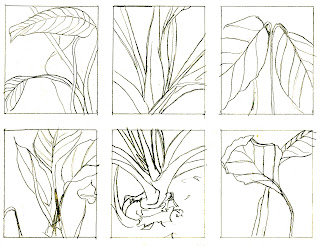
Where would we be without our thumbnails? We would be in pain and misery, that's where we would be. Our fingers would be wrapped in band-aids and nothing would ever get done. And that is the same place we would be without thumbnail sketches! Okay, maybe our fingers wouldn't be covered with band-aids, but we would be in pain and misery trying to complete an interesting drawing or painting. Thumbnail sketches are very valuable to the botanical or representational artist. It is in the thumbnail sketch (a small simple line drawing exploring composition and shapes) that:
- helps the artist explore the most effective and interesting view of their subject
- captures the energy of the first ideas behind the final composition
- defines the proportion of the final composition, and
- informs the artist what they need to observe, research or explore more deeply before investing lots of time into a project
I always first explore my compositions with thumbnail sketches, often done during boring meetings at work, and then expand them from there. To see an example of a book cover developed from a one inch sketch, click here.






